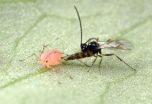(Press-News.org) Researchers at the RIKEN-MIT Center for Neural Circuit Genetics have discovered an answer to the long-standing mystery of how brain cells can both remember new memories while also maintaining older ones.
They found that specific neurons in a brain region called the dentate gyrus serve distinct roles in memory formation depending on whether the neural stem cells that produced them were of old versus young age.
The study will appear in the March 30 issue of Cell and links the cellular basis of memory formation to the birth of new neurons -- a finding that could unlock a new class of drug targets to treat memory disorders.
The findings also suggest that an imbalance between young and old neurons in the brain could disrupt normal memory formation during post-traumatic stress disorder (PTSD) and aging. "In animals, traumatic experiences and aging often lead to decline of the birth of new neurons in the dentate gyrus. In humans, recent studies found dentate gyrus dysfunction and related memory impairments during normal aging," said the study's senior author Susumu Tonegawa, 1987 Nobel Laureate and Director of the RIKEN-MIT Center.
Other authors include Toshiaki Nakashiba and researchers from the RIKEN-MIT Center and Picower Institute at MIT; the laboratory of Michael S. Fanselow at the University of California at Los Angeles; and the laboratory of Chris J. McBain at the National Institute of Child Health and Human Development.
In the study, the authors tested mice in two types of memory processes. Pattern separation is the process by which the brain distinguishes differences between similar events, like remembering two Madeleine cookies with different tastes. In contrast, pattern completion is used to recall detailed content of memories based on limited clues, like recalling who one was with when remembering the taste of the Madeleine cookies.
Pattern separation forms distinct new memories based on differences between experiences; pattern completion retrieves memories by detecting similarities. Individuals with brain injury or trauma may be unable to recall people they see every day. Others with PTSD are unable to forget terrible events. "Impaired pattern separation due to the loss of young neurons may shift the balance in favor of pattern completion, which may underlie recurrent traumatic memory recall observed in PTSD patients," Tonegawa said.
Neuroscientists have long thought these two opposing and potentially competing processes occur in different neural circuits. The dentate gyrus, a structure with remarkable plasticity within the nervous system and its role in conditions from depression to epilepsy to traumatic brain injury -- was thought to be engaged in pattern separation and the CA3 region in pattern completion. Instead, the MIT researchers found that dentate gyrus neurons may perform pattern separation or completion depending on the age of their cells.
The MIT researchers assessed pattern separation in mice who learned to distinguish between two similar but distinct chambers: one safe and the other associated with an unpleasant foot shock. To test their pattern completion abilities, the mice were given limited cues to escape a maze they had previously learned to negotiate. Normal mice were compared with mice lacking either young neurons or old neurons. The mice exhibited defects in pattern completion or separation depending on which set of neurons was removed.
"By studying mice genetically modified to block neuronal communication from old neurons -- or by wiping out their adult-born young neurons -- we found that old neurons were dispensable for pattern separation, whereas young neurons were required for it," co-author Toshiaki Nakashiba said. "Our data also demonstrated that mice devoid of old neurons were defective in pattern completion, suggesting that the balance between pattern separation and completion may be altered as a result of loss of old neurons."
INFORMATION:
The work was supported by the RIKEN-MIT Center for Neural Circuit Genetics, Howard Hughes Medical Institute, Otsuka Maryland Research Institute, Picower Foundation and the National Institutes of Health.
END
Stavros "LOTSandLOTS" Ioannou, one of the latest up and coming poker players to be sponsored and mentored by Badbeat.com, has begun with a winning streak that started with two MTTs then, the following week, 2nd in the EUR5k guaranteed EUR50 Turbo on Poker Time and 3rd in the $10k Guaranteed $5 Rebuy on Poker Encore for $2.1k. Now bankrolled and tutored by Badbeat.com, prospects look good for the young poker player.
"My first day with Badbeat.com was a good one -- I played 6 MTTs in total and final tabled 3/6 winning two of them," said Ioannou. "My ...
A new study reports that the disintegration of the Maya Civilization may have been related to relatively modest reductions in rainfall.
The study was led by Professors Martín Medina-Elizalde of the Yucatan Center for Scientific Research in Mexico and Eelco Rohling of the University of Southampton in the UK. Professor Rohling says:
"Our results show rather modest rainfall reductions between times when the Classic Maya Civilization flourished and its collapse – between AD 800-950. These reductions amount to only 25 to 40 per cent in annual rainfall. But they were large ...
Nursing home residents over the age of 65 who take certain antipsychotic medication for dementia are at an increased risk of death, suggests a research paper published today on bmj.com.
The Harvard Medical School study, the largest ever undertaken among US nursing home residents, looked at 75,445 older nursing home residents from 45 US states between 2001 and 2005. All nursing home residents studied were 65 and over. Risks of mortality were looked at during a six month period.
The US Food and Drug Administration (FDA) warned in 2005 that atypical antipsychotic drugs ...
In the war between parasite and host, the parasitic wasp, Aphidius ervi, and the pea aphid, Acyrthosiphon pisum, are locked in a battle for survival. New research published in BioMed Central's open access journal BMC Biology shows that this cunning parasite sniffs out differences between protected and unprotected aphids, and alters its egg-laying strategy, in order to overwhelm aphid defenses and ensure survival of wasp offspring.
The wasp, A. ervi, lays an egg inside the pea aphid, where the egg hatches and converts the aphid's insides into a wasp nursery. The wasp ...
Spacious new homes on large, hillside homesites in Fair Oaks Ranch are coming to Santa Clarita at Crest View, where Los Angeles homebuilder Pardee Homes has set Saturday, March 3 for grand opening festivities. The Crest View sales center will open at 10 a.m. and home shoppers are invited to enjoy self-guided tours of 4 fully decorated model homes.
Grand opening visitors can also take in a lively session with Sandy Krogh of Culinary Consultants. Demonstrating Crest View's upscale G.E. appliance line in a model home kitchen, Sandy will present delicious and easy springtime ...
Age-related macular degeneration (AMD) is one of the leading causes of blindness worldwide, especially in developed countries, and there is currently no known treatment or cure or for the vast majority of AMD patients. New research published in BioMed Central's open access journal Genome Medicine has identified genes whose expression levels can identify people with AMD, as well as tell apart AMD subtypes.
It is estimated that 6.5% of people over age 40 in the US currently have AMD. There is an inheritable genetic risk factor but risk is also increased for smokers and ...
In recent years, a number of controversial claims have been made about the female mammal's egg supply – that it is renewed over her adult lifetime (as opposed to the conventional understanding that she is born with all of her eggs), and that the source of these eggs is stem cells that originate in the bone marrow. Now, Weizmann Institute scientists have disproved one of those claims and pointed in new directions toward resolving the other. Their findings, based on an original method for reconstructing lineage trees for cells, were published online today in PLoS Genetics.
The ...
Scientists have discovered a new target in their fight against the devastating global disease 'malaria' thanks to the discovery of a new protein involved in the parasite's life cycle.
The research has uncovered a vital player in the sexual phase of the malaria parasite's reproduction which could prove an effective target for new treatments to stop the disease in its tracks.
The scientists from The University of Nottingham's School of Biology, with collaborators from the Universities of Leicester, Oxford, Imperial College London and Leiden in the Netherlands, have just ...
CHICAGO --- Millions of "good" bacteria exist harmoniously on the skin and in the intestines of healthy people. When harmful bacteria attack, the immune system fights back by sending out white blood cells to destroy the disease-causing interlopers. But how do white blood cells know which bacteria are good and which are harmful?
Northwestern University Feinberg School of Medicine researchers studied one type of white blood cell known as a macrophage, which is among the immune system's first to detect and eliminate harmful bacteria. The research team, led by Christian ...
Numerous mouse strains show great biological variation in features such as behavior, coat color and susceptibility to cancer and other diseases.
This study examines one possible genetic cause for differential gene expression and biological variation.
COLUMBUS, Ohio – The many short pieces of mobile DNA that exist in the genome can contribute to significant biological differences between lineages of mice, according to a new study led by researchers at the Ohio State University Comprehensive Cancer Center – Arthur G. James Cancer Hospital and Richard J. Solove Research ...



